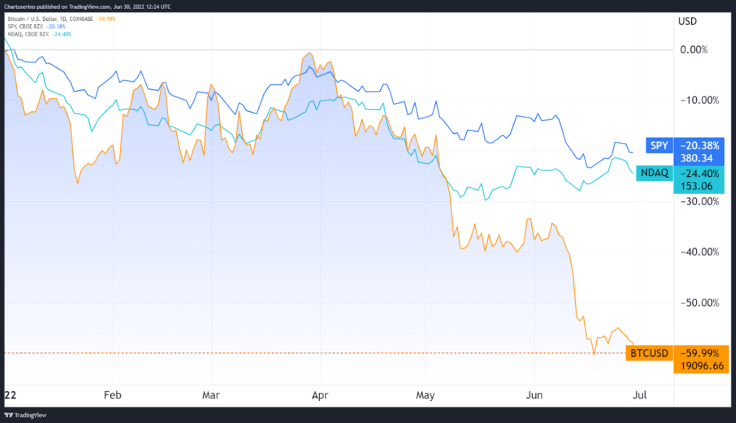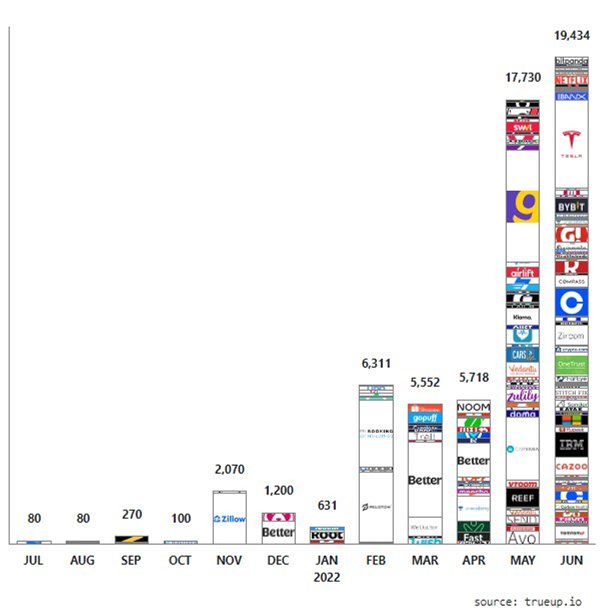Is Your Tech Job Ready For The Metaverse Cycle?
The IT sector is constantly maturing and getting more competitive. Growing roots from web1 to web2, the new hot commodity is web3 jobs. While previous thresholds revolved around greater interactivity and sleek design, the latest internet iteration is all about integrating digital assets.
Because they can be either cryptocurrencies or NFTs, this leaves plenty of room for growth for both art and coding jobs. It may seem odd to contemplate job growth in the current bear market, but one should think of it as a prelude to the inevitable transition to web3.
Blockchain Assets Down, VC Money Still In
We are entering a new economic cycle. As the Federal Reserve raises the cost of capital by hiking interest rates, more investors are reshuffling their investment portfolios. In turn, we have seen a downturn across the board. Year-to-date, S&P 500 went down by 20%, while Nasdaq and Bitcoin dropped by 24% and 60%, respectively.

This is what a fight against 40-year-high inflation looks like. Both the Fed and macroeconomists are bracing for a recession, which itself could have a suppressive effect on inflation as it lowers consumer demand. It also means that tech job losses have started to stack up across the board.

Nonetheless, it bears keeping in mind that cycles come and go. Ahead of the current one, web3 and metaverse jobs are poised to be the most sought ones. Case in point, just this June, Mastercard, with its active 725 million credit cards, is readying to put direct fiat-to-NFT payment rails into NFT marketplaces and layer 2 scalability networks.
Moreover, June ended with $3.6 billion in new funding rounds. While this is a decrease from May's $4.2 billion, it bears keeping in mind that these were unusually high levels. This signals investor consolidation, with quality projects still in demand.
In other words, once the economic engine churns up again, there will be more opportunities than ever for mass crypto/NFT/web3 adoption. The question is, what can you do to properly prepare for these opportunities?
Hone Your Skills

What does it take to become a web3 developer, one that combines the interactive web2 stack and blockchain-based technologies? While IT work is not for everyone, the barrier to entry is the lowest it has ever been, minus the basic computer hardware cost.
Alongside standard web2 technologies — HTML, CSS, JavaScript and PHP — one must also learn Solidity, Typescript, NodeJS, React, Git, JSON, MongoDB and API integrations on the web3 side of the equation. That may seem overwhelming, but there are plenty of resources (often free) that allow you to learn by practical examples.
For digital artists, things are simpler yet more complicated at the same time. To create NFTs and 3D gaming assets, one can take advantage of Blender, Maya, Adobe Photoshop or Unreal Engine 5 for integrating finished assets. However, each one requires extensive training to become proficient.
Typically, it doesn't get much better than courses on Gumroad to get started. That's because it allows for fierce competition that tends to lower the prices while elevating the content quality. Moreover, users can rate individual courses, so you can gauge if it is worth your time and dime.
Develop Your Personal Brand

With free social media platforms, such as Facebook, Twitter, Instagram, ArtStation and Reddit, it has become easy to put forward your portfolio for public scrutiny. Of course, digital artists have a considerable advantage here over coders. After all, the visual cortex is one of the most prominent parts of our brains.
As digital artist Beeple demonstrated, with his record-selling The First 5000 Days NFT, persistence is the key to success. For software engineers, the path to public recognition is a bit trickier. They would have to be involved with blockchain startups at entry-level jobs to prove their worth.
Nonetheless, coders too can enrich their profile with product design templates and hosted demos. Likewise, there is nothing that gets more attention than crafting thoughtful and productive responses to Twitter posts by more established crypto/web3 personalities with hundreds of thousands of followers.
Social Networking: IRL and Virtual

Those who have been following the development of Ethereum alone know that the entire space was birthed by hackathons and web3 conferences. In fact, existing metaverse platforms, such as Decentraland or The Sandbox, have become hosts for virtual social events.
Needless to say, it is more expensive to physically go to conferences for meet-and-greets. However, you never know which one may be scheduled in your local area. For this reason, one should bookmark Meetup.com aggregator to keep track of social networking opportunities.
But, that's the easy part. The more difficult part is getting prepared for the actual meetup, be it physical or virtual. For this reason, make sure you understand who will be attending the event, their background and what you can do to contribute to the discourse in a productive manner.
Add Freelance Writing into the Mix

Blockchain technology is a complex subject that requires expert knowledge. In turn, it is low in supply and high in demand. If you have experience in making complex ideas accessible, you could start your own blog, mapping your web3 journey.
This would give you inroads with more established publications, such as Business Insider, Forbes or Hacker Noon. You can offer them guest articles, and if you do a good job, you can drastically boost both your social networking and your social standing in the web3 community.
Outside coding, you could engage in crafting immersive lore for NFT projects. Provided you have a good background in English literature and fantasy/sci-fi genres, originality and playfulness pay off.
Level up Your Scarcity
If you are a software engineer, you most likely already have expertise in the aforementioned web2/web3 stacks. However, technology is always moving ahead. To get in that fast lane, you could specialize in:
- Deep Learning
- Computer Graphics
- Computational Imaging
Advancing to a Ph.D. level in any of these fields would mark you as a highly valued prize across national borders. After all, every technology we have today is based on Ph.D.-level work first.
Understand the Ecosystem
When all is said and done, getting a web3 job is positioning yourself at the right time in the right place. To get in that position, you must be noticed first, and people tend to do that when they see something of value to them.
Thankfully, metaverse envelopes a wide range of skills, from digital artistry to coding and storytelling. With all things equal, this gives you plenty of opportunities to laser-focus on your strong suit.

© Copyright IBTimes 2024. All rights reserved.





















